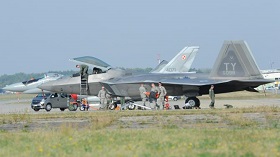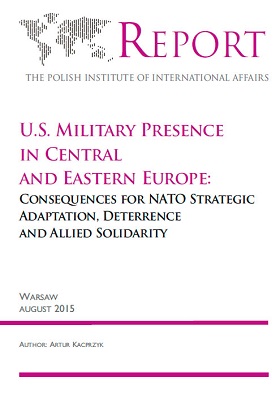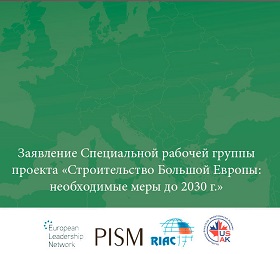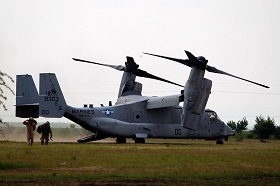The Ukrainian crisis has had a number of consequences for the international community: the economic sanctions have given Russia very little room for manoeuvre on the global market; and the political opposition of Western countries to Russia has buried the G8, along with any chance of large-scale joint initiatives being implemented in the future. The depiction of the growing confrontation between Russia and the West in Poland and the Baltic has led to a rather unbalanced and subjective view of their neighbour to the east. More than this, it has provided fertile ground for the publication of research papers calling for the United States to ramp up its military presence in these countries.
The Polish Institute of International Affairs (PISM) released one such report in August 2015: “U.S. Military Presence in Central and Eastern Europe: Consequences for NATO Strategic Adaptation, Deterrence and Allied Solidarity”.
The author of the paper, Artur Kacprzyk, calls for increasing the number of U.S. troops in Central and Eastern Europe, taking into account the fact that the United States has been a more decisive and capable ally of these countries since the outbreak of the conflict in Ukraine and the onset of Russia’s perceived “hostility”. The question of deploying troops is simply a logical continuation of the Pentagon’s intention to place its heavy weaponry in the so-called “New Europe” in order to meet the requirements of the U.S. military stationed in the region on a rotational basis (link in Russian).
Kacprzyk frequently uses the term Central and Eastern Europe (“U.S. actions have been received very warmly among CEE countries, which are concerned about Russia’s behaviour”), but refers only to Poland and the Baltic countries specifically. The Central and Eastern European Countries that are not mentioned in the report reject the notion of U.S. troops being stationed permanently on their territory. Slovakia and the Czech Republic have refused to have heavy weapons based in their countries, while Hungary, which is concerned about a reaction from Moscow, has agreed to house 50 armoured vehicles in return for U.S. investment in the modernization of the country’s military infrastructure (links in Slovak, Czech and Hungarian, respectively).
Estonia, Latvia, Lithuania and Poland welcomed the U.S. initiative to station heavy weaponry on their territories, seeing it as a way to ensure that Washington will safeguard the security of the Baltic region. Kacprzyk argues that the more the United States signals its commitment to Baltic security, the higher the risk for Russia that its “aggression against NATO” will result in a global conflict with world’s most powerful military superpower. What the report fails to analyse, however, is why Russia would want to attack Poland or the Baltic countries in the first place. The author goes on to suggest that Moscow might use the Russian diaspora in the Baltics to incite a political crisis, which would lead to the inevitable intervention on the part of Russia to protect its citizens living in the region. Yet Kacprzyk fails to mention that the problem of the Russian diaspora in the Baltic states could be resolved by providing them with basic human rights (right now, some 300,000 non-Latvian and 100,000 non-Estonian Russians do not have the right to vote or run for office), which would address the issue of security in the region far more effectively that focusing on the imaginary, but inevitable, threat from Russia.
Kacprzyk states that the speed and scope of U.S. actions have since the start of the Ukrainian crisis been unmatched by those of their NATO allies. As early as March 2014, before any actions had been taken by NATO, the Pentagon deployed airborne early warning radar systems in the Baltic region. The report highlights the fact that the United States remains the only country that has consistently stationed forces in the countries concerned, albeit on a rotational basis.
Two-Pronged U.S. Defence
Two parallel initiatives exist with regard to Polish, Lithuanian, Latvian and Estonian security: the Readiness Action Plan (RAP) and the European Reassurance Initiative (ERI).
The Readiness Action Plan was formulated at the NATO Summit in Newport, Wales, in September 2014. It involves, among other things, increasing the presence of NATO fighter jets in Baltic air space, carrying out surveillance flights over interested Eastern European Countries, sending more naval ships to patrol the Baltic Sea and deploying ground troops on a rotational basis. The Plan also involves the pre-positioning of military equipment and supplies in Eastern Europe and improving the infrastructure of the member countries, although it turned out that these measures would be implemented on a bilateral basis.
Kacprzyk identifies the decision to open NATO command centres in Eastern Europe and the creation of NATO’s Rapid Response Force, which is capable of deploying troops to the Baltics or Poland within one to two days. The 5,000-strong NATO Rapid Response Force will be heavily reliant upon the United States, as it is led by the U.S.-born Supreme Allied Commander Europe. It will also play a key role in intelligence, logistical support, the Special Forces and refuelling, among other things.
The European Reassurance Initiative security is a wholly American idea. With a budget approaching 1 billion dollars, it is a priority instrument for the Pentagon to carry out military manoeuvres in Central and Eastern Europe and deploy troops there on a rotational basis. The widely publicized anti-missile manoeuvres carried out by the United States in March 2015 and the march of the U.S. 2nd Cavalry Regiment through the region were part of the initiative.
Kacprzyk sees the European Reassurance Initiative as being “complementary” to the Readiness Action Plan. In reality, however, they are two vectors of a single foreign policy, where the differences between the two programmes can be explained by an aversion (on the part of the Pentagon) to act multilaterally.
In this way, Kacprzyk can overdo the apologetics for the military and political actions of the United States. Discussing the decision of the White House to station heavy weaponry in Poland and the Baltic countries in the run-up to the NATO Defence Ministers meeting, the author talks about the United States displaying its “leadership” and the “ability to make a meaningful contribution” to the Alliance. These steps by the United States should be interpreted as a unilateral abuse of power, one that challenges the (declared) method of making decisions collectively within NATO.
The term “sovereignty”, which is bound to appear when troops are being deployed in these countries, cannot be found anywhere in the report. For that matter, “unilaterally” is used only once – Kacprzyk argues that if Russia were to launch an attack, a reaction could be much more likely if the United States were to act unilaterally, rather than in lockstep with the NATO Rapid Response Force. The report contains a section entitled “The Positive Impact of U.S. Actions on NATO and Its Reception in the CEE” and ignores the negative consequences of such actions – the loss of national sovereignty and the increased influence of the United States on the internal political life of the country. As such, the report begins to look even more like propaganda.
Apologia for unilateralism
The author argues that stationing American troops outside NATO programmes would make for more effective defence. The Russian army, which has on more than one occasion proved to be able to redeploy its forces quickly may, Kacprzyk believes, launch a lightning-swift operation and “cut off” the Baltic states from the rest of the continent and, taking advantage of the location of the Kaliningrad Region, block NATO forces’ advance. The advantages of the stationing of American forces: in the event of a Russian attack, the US military. owing to prompt decision-making (unlike the bureaucratic NATO) and its professionalism could hold off the Russian army until reinforcements arrived in the conflict zone. Besides, in that case the Russian army would be attacking the NATO leader, which would inevitably prompt a reaction from other Western states. Whether due to lack of professionalism or the claim to being scientific in promoting wishful thinking – ungrounded speculations in this work are too much in evidence.
The main thrust of the PISM report is that in spite of the measures and initiatives the US and NATO have taken up until now, Poland, Lithuania, Latvia and Estonia still need a constant US military presence on their territories in order to oppose the Russian threat. The author is aware that several obstacles would have to be overcome to achieve that goal and proposes some original if not well-thought-out solutions.
The 1997 Russia-NATO Founding Act contains a clause that commits NATO to collective defence without a substantial additional permanent deployment of forces. After the reunification of Russia and the Crimea, the author believes, “the current and foreseeable” security conditions in Europe have changed so that the Alliance has to choose one of three options:
- To get NATO to define “substantial combat forces” without violating the Founding Act and to proceed from it;
- (because it is too late to agree with Russia on “substantial combat forces”) to proceed from earlier Russian proposals and deploy forces at not higher than brigade level;
- To dump the Founding Act which unduly limits NATO’s possibilities.
The second option is the most notable because it puts all the shortcomings of the Kacprzyk report in high relief. Russia indeed had proposed to NATO to seal the proposition that “deployment on a permanent basis of the Alliance’s forces above brigade level on the territories of new member countries of the Alliance would not correspond to the new character of the relations between the RF and NATO.” But the proposal was rejected by the North Atlantic Alliance. The report sidesteps the issue of how a rejected proposal can be used as a starting point of NATO strategy.
Fears and wishes
It is impossible to say precisely what the PISM report is, but basically it is a simple plea to the United States to act. The author stresses that although Poland and the Baltic countries would receive the armed forces of other NATO countries on their territories, they are first and foremost interested in the deployment of the American army stressing its professionalism and its ability to lead the other Western countries (another euphemism).
Along with expressing the Polish establishment’s wishes, Kacprzyk also reveals its fears, for example the fear that Congress or the White House could decide that the security of Poland and the Baltic countries is less of a priority than the implementation of the agreement with Iran and opposing the Islamic State, or scale down aid to the countries in the region due to financial constraints. He is also aware of the problems of the European NATO members which are reluctant to pull their weight in military spending (2% of GDP) and provoke a conflict with Russia. Germany traditionally opposes the creation of NATO military bases in Poland and does not intend to take part in the escalation of military-political confrontation with Russia proposing to revitalize the Russia-NATO Council.
The implementation of the goal hinges on whether the United States is willing to take such a step. Given the will, notwithstanding the pivot towards Asia, the objections of European NATO countries, the need to go it alone, the risk of provoking retaliatory measures by Russia, Washington would not think twice before deploying a brigade of its crack forces in Poland and the Baltic countries. However, for the American establishment these are only marginal themes against the background of practically universal foreign policy chaos that broke loose in recent years, which is why the White House finds it convenient to reproach its NATO partners of not being dedicated enough to the idea of atlanticism and unity against the Russian threat etc.
Calls to deploy American forces are likely to recur as the next NATO summit approaches. It will be held in Warsaw in July 2016. Considering that the United States, not wishing to make abrupt moves, especially in the year of presidential elections, will probably choose not to station permanent troops in the Baltic countries, the hope that the plan would be implemented may fizzle out even earlier. The PISM report makes no forecasts. But then there is no need for them because political appeals are made not to be studied or to be truthful, but to be heard by somebody.









